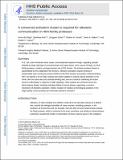A Conserved Activation Cluster Is Required for Allosteric Communication in HtrA-Family Proteases
Author(s)
de Regt, Anna K.; Kim, Seokhee; Sohn, Jungsan; Grant, Robert A.; Baker, Tania A.
DownloadBaker_A conserved.pdf (1.963Mb)
PUBLISHER_CC
Publisher with Creative Commons License
Creative Commons Attribution
Terms of use
Metadata
Show full item recordAbstract
In E. coli, outer-membrane stress causes a transcriptional response through a signaling cascade initiated by DegS cleavage of a transmembrane anti-sigma factor. Each subunit of DegS, an HtrAfamily protease, contains a protease domain and a PDZ domain. The trimeric protease domain is
autoinhibited by the unliganded PDZ domains. Allosteric activation requires binding of unassembled outer-membrane proteins (OMPs) to the PDZ domains and protein-substrate binding. Here, we identify a set of DegS residues that cluster together at subunit-subunit interfaces in the
trimer, link the active sites and substrate-binding sites, and are crucial for stabilizing the active enzyme conformation in response to OMP signaling. These residues are conserved across the HtrA-protease family, including orthologs linked to human disease, supporting a common
mechanism of allosteric activation. Indeed, mutation of residues at homologous positions in the DegP quality-control protease also eliminates allosteric activation.
Date issued
2015-02Department
Massachusetts Institute of Technology. Department of BiologyJournal
Structure
Publisher
Elsevier
Citation
de Regt, Anna K. et al. “A Conserved Activation Cluster Is Required for Allosteric Communication in HtrA-Family Proteases.” Structure 23.3 (2015): 517–526.
Version: Author's final manuscript
ISSN
0969-2126
1878-4186